The tour of Ft. Greene Park led by Greg Trupiano was not only informative but inspirational. I left the tour with a much greater understanding of Ft. Greene because of the information presented. The tour began at the visitor’s center in Ft. Greene Park and Greg began to present the history and relevance of Whitman to this park. What was especially pleasing was that Greg brought along a gentleman who read selections of Whitman with great presence. It is always great to hear Whitman spoken aloud, as I believe he wrote it to be spoken aloud. In addition there was in attendance a member of the conservatory, Charles, who had quite a bit to contribute about the park. During the presentation Nicole sang Whitman’s words. She is a professional Opera singer. Her voice resonatedwithin me long after the tour had ended. The fourth person in attendance was an expert on Crown Heights and Bed-Stuy. She was also able to contribute her knowledge to the experience. The prison ship martyr’s monument in Ft. Greene Park is over the crypt of bones from the prisoners’ ships in the harbor. There is one full set of remains, the of Benjamin Romaine, and the vault can only be opened by the great great great great granddaughter of Benjamin Romaine, Vicki Romaine. There are lots of other bones in the crypt, but none as complete. They washed up on the shores of the old Navy Yard, and in the morning the prisoners ships would turn over thir dead and they would be buried in shallow graves where the old Navy Yard is today. The water would uncover the bones and the remains were collected for this crypt. There was lots of talk of the Old Jersey. Whitman writes in New York, “the principal of these prison ships was the old Jersey, a large 74-gun …the one which seems to have been most relied on was the old Jersey. The British took a great manyAmerican prisoners during the war-not only by land, but also by their privateers, at sea. When a capture was made in any of the waters near enough, the prisoners were brought with the vessel to New York. These helped to swell the rank of the unhappy men, who were crowded together in the most infernal quarters, starved, diseased, helpless, and many becoming utterly desperate and insane.-Death and starvation killed them off rapidly” (31). More men died on these ships than died in the entire Battle of Brooklyn. When word got back to Great Britain about these deaths it brought a lot of shame on the soldiers. The anonymity between American and Great Britain remained up until the first World War. After the great presentation at the crypt, we moved on to Whitman’s only standing residence in Brooklyn, 99 Ryerson Street. We gathered across the street and had a question and answer exchange. It is our understanding that everybody who lives in their is quite aware that this is Whitman’s house. Many of the tennants have been students of Pratt. Then we walked back towards CUNY as a group. It was a beautiful day for a tour, and we all left more inspired than we had arrived three hours earlier.Please enable Javascript and Flash to view this Flash video.
Posts Tagged ‘fieldtrip’
Chuck For Dec. 2nd
Sunday, November 29th, 2009Chuck for Oct. 20th
Wednesday, October 21st, 2009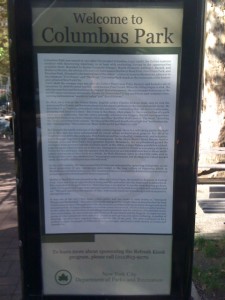
This morning I embarked on a quest to seek out the location of the current day “5 Points”. I was headed towards the corner of Worth and Baxter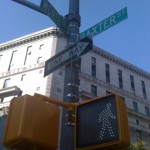 . Having parked my car on Mott, a block from Doyer, I had to pass through Columbus Park to get to Worth and Baxter. While in Columbus Park I came across the above pictured sign. It further confirmed the description that Dickens’ gave of the 5 points in his review of New York. The sign read as follows, “In 1842, on a visit to the United States, English author Charles Dickens made sure to visit the notorious Five Points, and he wrote about it in his American Notes in the most scathing terms. He described it as ‘reeking everywhere with dirt and filth,’ concluding that ‘all that is loathsome, drooping and decayed is here'”. The sign also quotes Danish newspaperman Jacob Riis and his description of the area in the 1890’s. It states, “Jacob Riis devoted an entire chapter of his epic How the Other Half Lives to ‘The Bend,’ detailing the ‘foul core of New York’s slums.’ He likened the filth and dearth of sunlight to a “vast human pig-sty,’claiming that “There is but one ‘Bend’ in the world, and that is enough.'” As I was reading the sign I introduced myself to an employee of the Parks Dept. to find the exact location of the Five Points. He suggested I was in the thick of it. Then I inquired where was the corner of Worth and Baxter and he pointed to a corner of the park. As I began to head in that direction I was approached by an elderly Asian woman who asked if I wanted to see the oldest part of the area. I said “yes”. She directed me to 15 Doyers St
. Having parked my car on Mott, a block from Doyer, I had to pass through Columbus Park to get to Worth and Baxter. While in Columbus Park I came across the above pictured sign. It further confirmed the description that Dickens’ gave of the 5 points in his review of New York. The sign read as follows, “In 1842, on a visit to the United States, English author Charles Dickens made sure to visit the notorious Five Points, and he wrote about it in his American Notes in the most scathing terms. He described it as ‘reeking everywhere with dirt and filth,’ concluding that ‘all that is loathsome, drooping and decayed is here'”. The sign also quotes Danish newspaperman Jacob Riis and his description of the area in the 1890’s. It states, “Jacob Riis devoted an entire chapter of his epic How the Other Half Lives to ‘The Bend,’ detailing the ‘foul core of New York’s slums.’ He likened the filth and dearth of sunlight to a “vast human pig-sty,’claiming that “There is but one ‘Bend’ in the world, and that is enough.'” As I was reading the sign I introduced myself to an employee of the Parks Dept. to find the exact location of the Five Points. He suggested I was in the thick of it. Then I inquired where was the corner of Worth and Baxter and he pointed to a corner of the park. As I began to head in that direction I was approached by an elderly Asian woman who asked if I wanted to see the oldest part of the area. I said “yes”. She directed me to 15 Doyers St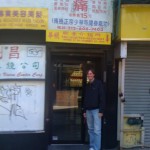 . which was very close to where I parked the car. She had suggested that there was a passageway under the buildings about three stories down. I was excited to hear this as Dickens has been in my head since reading his review of New York, especially the part where he describes, “Ascend these pitch-dark stairs, heedful of a false footing on the trembling boards, and grope your way with me into this wolfish den, where neither ray of light nor breath of air, appears to come. A negro lad, startled from his sleep by the officer’s voice-he knows it well-but comforted by his assurance that he has not come on business, officiously bestirs himself to light a candle. The match flickers
. which was very close to where I parked the car. She had suggested that there was a passageway under the buildings about three stories down. I was excited to hear this as Dickens has been in my head since reading his review of New York, especially the part where he describes, “Ascend these pitch-dark stairs, heedful of a false footing on the trembling boards, and grope your way with me into this wolfish den, where neither ray of light nor breath of air, appears to come. A negro lad, startled from his sleep by the officer’s voice-he knows it well-but comforted by his assurance that he has not come on business, officiously bestirs himself to light a candle. The match flickers
for a moment, and shows great mounds of dusty rags upon the ground; then dies away and leaves a denser darkness than before, if there can be degrees in such extremes. He stumbles down the stairs and presently comes back, shading a flaring taper with his hand. Then the mounds of rags are seen to be astir, and rise slowly up, and the floor is covered with heaps of negro women, waking from their sleep: their white teeth chattering, and their bright eyes glistening and winking on all sides with surprise and fear, like the countless repetition of one astonished African face in some strange mirror.” (From American Notes For General Circulation, pg. 61). As I approached this nondescript glass door that was open and unattended, I found myself looking down a staircase and spotted a cat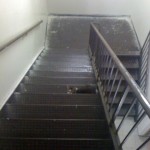 which furthered my feelings of an unkempt underground passage. There were several staircases and some closed exits blocked by garbage cans
which furthered my feelings of an unkempt underground passage. There were several staircases and some closed exits blocked by garbage cans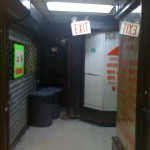 ; it felt as though I traveled several stories underground before finding myself at the foot of the stairs. I then proceeded down a winding and turning hallway
; it felt as though I traveled several stories underground before finding myself at the foot of the stairs. I then proceeded down a winding and turning hallway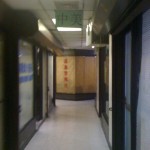 which felt as though it was longer than two city blocks. There were several shops, most of them abandoned, and the few that were open (one being an employment agency) had signs written in Chinese. It gave an overall feeling of being in an unfamiliar place, such as Dickens must have felt on his first voyage to New York. At the end of the long and winding corridor I found myself looking up a long flight of stairs with an exit sign. As I proceeded up the stairs I felt the sunlight shining
which felt as though it was longer than two city blocks. There were several shops, most of them abandoned, and the few that were open (one being an employment agency) had signs written in Chinese. It gave an overall feeling of being in an unfamiliar place, such as Dickens must have felt on his first voyage to New York. At the end of the long and winding corridor I found myself looking up a long flight of stairs with an exit sign. As I proceeded up the stairs I felt the sunlight shining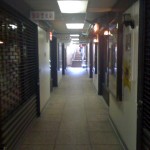 in through the glass door and walked out into Chatham Sq.
in through the glass door and walked out into Chatham Sq.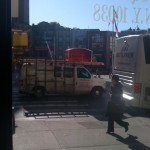 After my impromptu adventure, set off by the elderly Asian woman, I returned to the corner of Baxter and Worth
After my impromptu adventure, set off by the elderly Asian woman, I returned to the corner of Baxter and Worth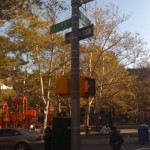 and took in the view of the Five Points (Columbus Park) from that vantage point. It being so early in the morning with so few inhabitants it was easy to imagine what it must have been like in the 1800’s thanks to the culmination of the readings, the park, and my short adventure underground.
and took in the view of the Five Points (Columbus Park) from that vantage point. It being so early in the morning with so few inhabitants it was easy to imagine what it must have been like in the 1800’s thanks to the culmination of the readings, the park, and my short adventure underground.